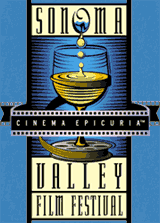|
The
Sonoma Valley Film Festival:
Long Gone
 There
is a saying that the rails call to a man at his darkest hours.
This must be true, for I can't think of a darker set of humans
than those who were chronicled in the outstanding documentary
Long Gone. There
is a saying that the rails call to a man at his darkest hours.
This must be true, for I can't think of a darker set of humans
than those who were chronicled in the outstanding documentary
Long Gone.
Shown
as a part of the Sonoma Valley Film Festival's Lounge program,
Long Gone is an exceptionally powerful film that tells
the story of the men and women who travel America courtesy
of American freight trains. It is also the story of what happens
when people lose hope, find freedom, and try their damnedest
to make themselves a family from what they pull together.
If you
were simply to look across the surface of this marvel, you
would see only the cinematography, which is easily the finest
I've seen in any documentary for years. Much like Confessions
of a Burning Man, the subject just lends itself to
beautiful shooting. There are grand vista shots, sweeping
views of the countryside as it rolls by, and amazing looks
at the squalor that some of these people live in. It's easy
to see why Long Gone won the Slamdance prize for Best
Cinematography.
You can't
watch the film without noting the powerful music of Tom Waits
and Kathleen Brennan. They provide another layer, making the
whole piece come off even more desperate and sheltered.
The next
level down are these amazing characters with crazy names.
Horizontal John. Joshua Long Gone. New York Slim. Dog Man
Tony. They sound like names that could have come out of 1930s
hobo movies, and in essence, they are the last remaining vestige
of those days. They are real people, though at times it's
hard to look at them as human. They are entertaining, especially
the philosophical New York Slim, and at times, a bit scary.
They know that they are not what the rest of the world wants
them to be, and this only bothers one or two of them throughout
the film. There is a sense of loneliness to every character,
even the best friends Joshua Long Gone and Horizontal John.
Though they travel together, there is always a sense of isolation
to them. The characters are deep and as the shoot took almost
four years, we get to watch every character develop, morph,
and a couple of them even die.
A nearly
tragically mismatched couple, Jessie and Stoney, travel across
the US, ending up in NYC. They are just out to have a good
time and explore, but it becomes obvious that Jessie is a
remarkable young woman, shown playing classic piano in one
scene, and Stoney is a strung-out loser. It's hard to watch,
but nice to see where each of them ends up.
These
characters have their fights, their slugfests, their painful
break-ups, their quiet sicknesses. The filmmakers seem to
be more interested in watching the events that shape these
people and this way of life. There is a frightening feeling
as we watch one of the tramps slowly waste away that the filmmakers
are documenting when they should be intervening, but then
when you realize that his closest riding partner can't get
him to get help that they were equally powerless.
Once you've
come past the easy parts, you get to the ultimate core: this
is the price we pay for what we all want, the price for our
freedom. It's a hard lesson that. Most folks say they are
working towards complete freedom and here it is shown as a
rougher road than the one you walk to get there. We see people
who chose this life, only to have to deal with far greater
pain now that they've achieved what they were looking for.
It's the oldest story in the world: be careful what you ask
for, and here, it is shown at its darkest.
We see
the filmmakers go far in their attempt to document this lifestyle,
but they also refuse to pull back when they might want to
put the camera away. Documentary ethics and those of the average
viewer often come into stark contrast in these situations.
We see graphic drug use at one point, an illness conquer a
vibrant personality, a series of brutal fights. All of this
leaves you numb at times, but there is still something amazing
creeping in at the edges. Perhaps it is simply the beauty
of the work and the music. Perhaps it is the charisma of the
characters, or some left-over romantic notion of hobos from
our parents and grandparents. Whatever that feeling is, it's
certainly there, and that is what makes this film more than
just a charming piece of whimsy.
|
 There
is a saying that the rails call to a man at his darkest hours.
This must be true, for I can't think of a darker set of humans
than those who were chronicled in the outstanding documentary
Long Gone.
There
is a saying that the rails call to a man at his darkest hours.
This must be true, for I can't think of a darker set of humans
than those who were chronicled in the outstanding documentary
Long Gone.





